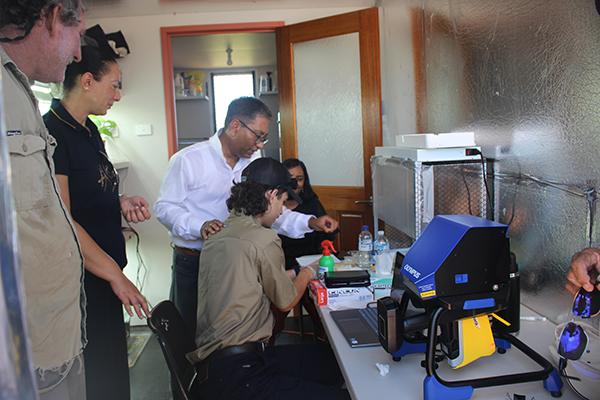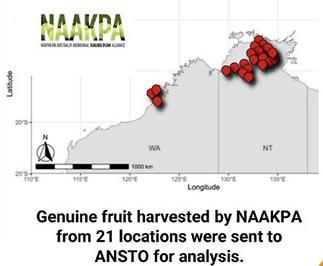ANSTO is collaborating with the Northern Australia Aboriginal Kakadu Plum Alliance Co-operative Limited (NAAKPA) on an Indigenous Bushfoods Provenance Technology project, funded by the Department of Agriculture, Fisheries and Forestry (DAFF).
The project aims to enhance agricultural traceability by ensuring that farmgate producers can use and apply the elemental fingerprint technology developed by ANSTO.
“We greatly value this project to support Indigenous food businesses who face challenges due to fraudulent products in Australia and internationally,” said Dr Debashish Mazumder, Leader, Food Provenance.
A demonstration of the ANSTO’s elemental fingerprinting technology took place at a workshop organised by NAAKPA in Broome, WA, from January 20-24. Kakadu plum producers had the opportunity to learn how the portable x-ray fluorescence technology is used for an analysis of the elements in Kakadu Plum samples. The elemental profile is the basis of a unique fingerprint to confirm provenance with a high degree of accuracy.
This training workshop presented an opportunity for producers to add value to their products by providing a validation of its source of origin scientifically, rather than relying on a chain of custody ledger, to verify provenance.
Dr Debashish Mazumder and the ANSTO food provenance team, including Dr Carol Tadros, Ms Patricia Gadd, and Mr Jason Bertoldi, travelled to Broome to engage with local stakeholders and Kakadu Plum growers.

At the Indigenous Bushfoods Provenance Technology workshop, the team showcased the value of utilising a portable XRF unit to efficiently obtain on-site elemental data to benefit the industry. They demonstrated ANSTO’s capacity to process this data swiftly to generate precise elemental fingerprints for the verification of provenance.
Additionally, they had the opportunity to visit a local plantation and harvest Kakadu plum fruit for a secondary study investigating the impact of species variation on elemental profiles within a geographic location.
The team also met with rangers from Yawuru Minyirr-Buru Conservation Park to discuss key findings from a pilot project ANSTO conducted within NAAKPA and the Park. The project explored strategies to implement ANSTO’s provenance technology to deter illegal poaching within conservation areas.
Around 19 participants from four Indigenous organisations participated along with representatives from Department of Primary Industry and Regional Development.
Paul Saeki, CEO of NAAKPA said, ‘This workshop demonstrated how portable and cost effective elemental fingerprint scanning can be, and discussions on protocols which respect cultural systems, help inform application and usage of the technology in the bushfood sector.”
Indigenous farms participate in food origin studies
The ANSTO Food Provenance team has published a second paper relating to the verification of origin for Kakadu plum grown by traditional owners in the journal Food Control.
“The need to verify the origin of Kakadu plums has become important with the growth of the industry. A reliable method to track where the plums come from is essential for fair trade and to protect both consumers and First Nations businesses,” said first author Dr Carol Tadros.
The research examines the elemental composition of Kakadu plums from six northern Australian Indigenous enterprises, who are part of the Northen Australian Aboriginal Kakadu Plum Alliance (NNKPA). It follows previous proof of concept studies.

The authors gratefully acknowledge the Traditional Owners of the land and extend their gratitude for their collaboration in harvesting the Kakadu plums and respect their knowledge and experience regarding this fruit.
The geographic origin of the fruit can be determined by analysing elements including rubidium, copper, chromium, and magnesium, which come from the soil the plums grow in.
The techniques used in the study included high-resolution X-ray fluorescence (XRF) on the ITRAX core scanner and isotopic analysis to quickly and accurately measure the elements in the fruit, creating a “fingerprint” for identifying the plums’ origin.
The fingerprints were added to a reference database for the future verification purposes.
“This method could help prevent fraud in the industry and could even be applied using portable XRF devices to verify the origin of plums along the supply chain,” said Project leader, Dr Debashish Mazumder.
Ongoing research will refine the method, using more data, including samples from different harvest years and regions with similar soil types, to improve the accuracy of the classification.
Contributing authors included Dr Mazumder, Dr Jagoda Crawford, Patricia Gadd and Paul Saeki, CEO NAAKPA.








